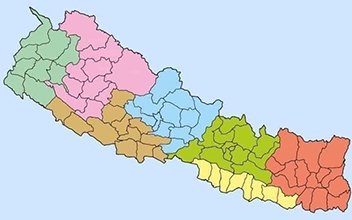 Professor Anand Aditya-----
Professor Anand Aditya-----
The absence of a comprehensive survey on self-perception does not allow generalization here at the theoretical level, hut a casual scan of the existing literature of Nepali people’s self-image suggests that they feel small, squeezed in between the elephantine weights of two giants whose geographical mass, economic productivity, military power, and cultural presence make it pale it into insignificance.
Size anxiety has stirred the Nepalese people throughout their history like nothing else. It was, indeed the size anxiety that prompted Laxmi Prasad Devkota to pen his famous essay on the theme decades ago and continues to dog Nepali minds to this day.
A closer look at the world data, however, suggests that the situation is not really so bleak and smallness in Nepal’s case is largely a matter of its specific context.
It may be deemed relatively small by its neighbors. But what is small, an epithet which has been used in is diverse a way as possible in history?
The world’s population in 8000. B.C is estimated to have been one-fourth of what Nepal now has.
Glassner gives the range for small states to be between 25,000 and 150,000 sq. kms. But Clark and Payne put the upper limit of smallness at 1 million or less population, a criterion used by the UN Institute for Training and Research in its Report on Small States in 1971 and adopted by the 1985 Commonwealth Consultative Group.
(Countries with population of 2 million or less are generally defined as microstates. David J. McCraw, on the other hand, regards the population size of under 10 million as the most important criterion for a small state.
Hollis Chenery pushes up the line still higher to 20 million, averring that the population of a country is the best measure of size because it influences its industrial prospects, an argument that could hold equally for both area and location.
Karl W. Deutsch, on his part, however, ranks political systems with population between 5 and 40 million as Middling Nation-States.
Smallness has thus been defined in very diverse ways.
Still, judged in terms of any such measure, Nepal is far from.
One of the smallest countries in the world as one Nepali author claims it is. In the ancient times, too, the Chinese traveler Hiuen Thsiang put Ni-Po-Los perimeter at 3,000 Li in circuit with the capital city of 20 Li round.
And, even the present level of population is equivalent to 4000 Greek poleis as per Aristotle’s criterion and 320.457 times the Vatican, the smallest nation-state on the map.
In area it compares closely to six countries-Guatemala, Honduras. Cuba, Malawi, Nicaragua, Surinam, and Uruguay.
Any fixation on number-based comparison alone, however, would be necessarily incomplete and ultimately misleading. For a fuller picture, therefore, we must also take a look at how a small state has been defined.
A small state, says L. G.M. Jaquet is a state that neither on a world scale or on a regional scale able to impose its political will or to project its national interest by exerting power politics.
R. L. Rothstein, on the other hand, defines the small state as one which recognizes that it cannot obtain security primarily by use of its own capabilities, and that it must rely fundamentally on the aid of other States, institutions, processes or developments to do so.
Thus, in terms of both political influence Jaquets template and security- Rothstein’s, Nepal would figure as a small state today.
But this has not been always so. In both influence and security factors which do not remain constant over time. Nepal’s relative position has fluctuated widely. To see how a brief recourse the memory lanes of our history for a while may help.
Actually, when this state was born, there were only 19 other states on the map.
The thirteen colonies of New England would unite into a federation only eighteen years later to give shape to the early stage of today’s United States of America; and Britain was busy forging the jewel of India into its imperial crown in the fires of Plassey and the battle of Buxor.
It was in 1768, the year Captain Cook started on his first voyage, the Royal Academy was founded in London, and the Russian and the Ottoman empires started their war in Europe that a scion of the House of Gorkha Prithvi Narayan Shah started welding together the hill-states of the Nepal.
# This article first appeared in the Telegraph Weekly/telegraphnepal.com in the year 2010.


